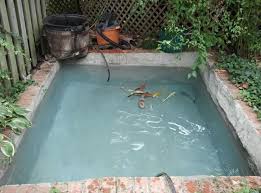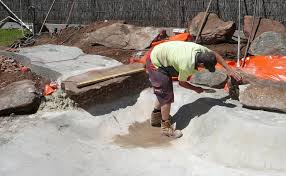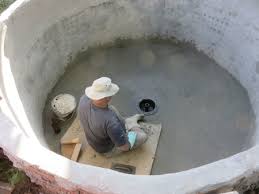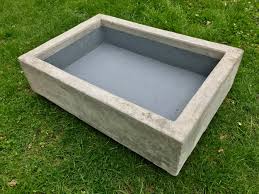Concrete ponds are increasingly popular for both aesthetic and functional purposes in landscaping and aquaculture. Unlike traditional ponds made from earth or plastic liners, concrete ponds offer unique advantages that cater to various needs, such as durability, customization, and maintenance.
These structures can serve multiple purposes, including decorative features in gardens, habitats for aquatic life, and even sources for water conservation. However, while concrete ponds present numerous benefits, they also come with certain disadvantages that potential owners should consider before committing to this type of water feature. Understanding both sides of the equation is essential for making an informed decision about whether a concrete pond aligns with individual goals and circumstances.
One of the most significant advantages of concrete ponds is their durability. Concrete is a robust material that can withstand harsh weather conditions, including freezing temperatures and heavy rains. Unlike plastic or rubber liners that may degrade over time, concrete offers a long-lasting solution, reducing the need for frequent repairs or replacements. This durability makes concrete ponds particularly appealing for individuals looking for a long-term investment in their landscape.
Another key benefit is the versatility in design and customization. Concrete can be molded into various shapes and sizes, allowing for creative expression in landscaping. Owners can design ponds that fit seamlessly into their gardens, whether they prefer a sleek modern look or a natural, organic shape. This flexibility also extends to features such as waterfalls, fountains, and lighting, which can enhance the visual appeal of the pond and create a tranquil atmosphere.
Concrete ponds also provide excellent water quality management. The material is less prone to leaching harmful chemicals into the water, making it a safer environment for fish and aquatic plants. Additionally, the solid structure allows for better control of water temperature, helping to maintain a stable ecosystem. Properly designed concrete ponds can also include filtration systems that aid in maintaining clean water, promoting the health of the aquatic life within.
However, despite these advantages, concrete ponds come with certain disadvantages. One notable drawback is the initial cost. The construction of a concrete pond can be significantly more expensive than other types of ponds, such as those using liners or preformed shells. This higher upfront investment can be a barrier for some individuals, particularly those on a tight budget.
Moreover, the installation of a concrete pond requires professional expertise. Unlike simpler pond types that individuals can construct themselves, concrete ponds demand skilled labor for proper design, pouring, and curing. This need for professional assistance can lead to additional costs and time delays, which may deter some potential pond owners.
Another consideration is the maintenance involved with concrete ponds. While they are generally durable, they can develop cracks over time due to shifts in the ground or freezing temperatures. Regular inspections and maintenance are essential to ensure the integrity of the structure, adding to the ongoing costs of ownership. Additionally, the rough surface of concrete may encourage algae growth, necessitating the use of chemical treatments or manual cleaning to keep the pond looking pristine.
Durability of Concrete Ponds

Concrete ponds are known for their durability, making them a preferred choice in various applications. Here are the factors contributing to their longevity:
1. Resistance to Weathering: Concrete is designed to withstand harsh weather conditions, including extreme temperatures, heavy rains, and UV exposure. This resilience ensures that the pond remains intact over time.
2. Structural Integrity: When properly constructed, concrete ponds can handle the pressure of water and withstand the weight of any aquatic plants or animals, preventing cracking or collapsing.
3. Low Maintenance: Unlike other materials, concrete requires minimal maintenance over its lifespan. Regular inspections and occasional repairs (like sealing cracks) are generally all that is needed.
4. Resistance to Pests: Concrete is impervious to pests like termites and rodents, which can compromise the integrity of ponds made from wood or other organic materials.
5. Longevity of Investment: While the initial cost may be higher, the long-lasting nature of concrete ponds makes them a sound investment, as they can last for decades with proper care.
Cost-Effectiveness of Concrete Ponds
Concrete ponds can be cost-effective in the long run, despite their initial investment. Here are the factors that contribute to their cost-effectiveness:
1. Reduced Replacement Costs: Due to their durability, concrete ponds do not require frequent replacements like other materials. This translates to savings over time.
2. Lower Maintenance Costs: The low maintenance needs of concrete ponds reduce the overall costs associated with upkeep. This includes fewer expenditures on cleaning, repairs, and treatments.
3. Increased Property Value: Well-constructed concrete ponds can enhance the aesthetic appeal of a property, potentially increasing its market value. This makes them a worthwhile investment for homeowners.
4. Versatile Uses: Concrete ponds can serve multiple purposes, such as aquaculture, ornamental features, or irrigation reservoirs. Their versatility means they can provide financial benefits in various ways.
5. Energy Efficiency: Due to their temperature regulation properties, concrete ponds can reduce energy costs associated with heating or cooling water, especially in aquaculture operations.
Read Also: 11 Medicinal Health Benefits of Barbarea vulgaris (Yellow Rocket)
Maintenance Requirements for Concrete Ponds

While concrete ponds are low-maintenance, some upkeep is necessary to ensure their longevity and functionality. Here are essential maintenance requirements:
1. Regular Cleaning: Remove debris, leaves, and algae buildup regularly to maintain water quality. Using nets or skimmers can help keep the pond clean.
2. Inspect for Cracks: Periodically check the pond for any signs of cracks or wear. Addressing minor issues promptly can prevent larger problems down the line.
3. Water Quality Monitoring: Regularly test the water for pH, ammonia, nitrite, and nitrate levels to ensure a healthy environment for aquatic life. This helps in preventing potential health issues.
4. Seasonal Maintenance: Before winter, prepare the pond for colder months by removing any sensitive plants and ensuring the pond is properly winterized. In spring, conduct a thorough cleaning to prepare for the warmer months.
5. Pest Control: Monitor for pests that may affect the pond’s ecosystem. Implement natural pest control measures, if necessary, to maintain a balanced environment.
Aesthetic Appeal of Concrete Ponds
Concrete ponds can significantly enhance the visual appeal of any outdoor space. Here are some aspects of their aesthetic benefits:
1. Customization Options: Concrete ponds can be designed in various shapes and sizes to match the specific style of your landscape. You can incorporate features like waterfalls, fountains, or decorative rocks to create a visually stunning focal point.
2. Natural Appearance: With the right finishing techniques, concrete can mimic natural materials like stone or slate. This allows for a more organic look that blends seamlessly into the surrounding environment.
3. Integration with Landscaping: Concrete ponds can be integrated into garden designs, surrounded by plants, flowers, and lighting. This integration creates a serene atmosphere and enhances the overall beauty of the landscape.
4. Durability of Features: Unlike other materials that may fade or deteriorate over time, concrete can maintain its aesthetic appeal for years with minimal maintenance. Decorative elements added to the pond, such as tiling or artistic sculptures, can also withstand weather conditions.
5. Year-Round Interest: Concrete ponds can be designed to provide visual interest throughout the seasons. Adding aquatic plants that bloom at different times of the year or using lights for evening ambiance keeps the area vibrant and engaging.
Environmental Considerations of Concrete Ponds
While concrete ponds offer many benefits, it’s essential to consider their environmental impact. Here are some key points to keep in mind:
1. Water Usage: Concrete ponds can conserve water better than traditional earthen ponds due to their non-porous surfaces. This can be advantageous in regions facing water shortages.
2. Aquatic Habitat: Properly maintained concrete ponds can support aquatic life and biodiversity, providing habitats for fish, amphibians, and beneficial insects. Incorporating natural elements like plants can further enhance the ecosystem.
3. Chemical Leaching: There’s potential for leaching from concrete, especially if the mix includes harmful additives. It’s important to use environmentally friendly materials and sealants to minimize any negative effects on water quality.
4. Runoff Management: Concrete surfaces can contribute to increased runoff if not designed with drainage in mind. Implementing effective drainage systems can help manage runoff and reduce soil erosion around the pond.
5. Energy Use: The initial construction of concrete ponds may require significant energy input. However, their long-term durability can offset this impact by reducing the need for replacement materials.
Read Also: 11 Medicinal Health Benefits of Yellow Water-lily (Nuphar Advena)
Advantages of Concrete Ponds

Concrete ponds offer several advantages for aquaculture, gardening, and landscaping. Here are some key benefits:
1. Long Lifespan: Concrete is a robust material that can withstand various environmental conditions. It does not rot, corrode, or decay like wood or metal, ensuring a long-lasting pond structure.
2. Customizable Shapes and Sizes: Concrete allows for flexibility in design, enabling you to create ponds of different shapes and sizes to fit your space and aesthetic preferences.
3. Enhanced Water Quality: The smooth surfaces of concrete ponds can help maintain water quality by reducing algae growth and providing a stable environment for aquatic life.
4. Easier Cleaning: The non-porous surface of concrete makes it easier to clean compared to other materials. This reduces the buildup of debris and algae, ensuring a healthier environment for fish and plants.
5. Stable Temperature Regulation: Concrete provides insulation, helping to maintain a more stable water temperature compared to other materials. This can benefit aquatic life by reducing stress caused by temperature fluctuations.
Disadvantages of Concrete Ponds
Despite their numerous advantages, concrete ponds also have some disadvantages to consider:
1. Initial Cost: The upfront cost of constructing a concrete pond can be higher than other materials due to labor and material expenses. This may be a barrier for some homeowners or small-scale farmers.
2. Cracking Issues: While concrete is durable, it can crack over time, especially if not installed correctly or exposed to extreme temperature changes. Regular maintenance is required to address these issues and ensure the pond’s integrity.
3. Lack of Flexibility: Once constructed, concrete ponds are challenging to modify. Any changes to size or shape may require significant effort and expense.
4. Temperature Regulation: Concrete can absorb heat, which may lead to higher water temperatures in warmer climates. This could stress aquatic life and require additional cooling measures.
5. Limited Natural Filtration: Unlike natural ponds that rely on soil and vegetation for filtration, concrete ponds may need additional systems to maintain water quality. This can increase maintenance and operational costs.
Impact on Aquatic Life
Concrete ponds can significantly impact aquatic life, both positively and negatively. Understanding these effects is crucial for maintaining a healthy ecosystem within the pond.
1. Habitat Creation: Concrete ponds can provide a stable environment for various aquatic species, including fish, amphibians, and beneficial microorganisms. The design and maintenance of the pond can enhance biodiversity by creating niches for different organisms.
2. Water Quality Maintenance: Proper management of concrete ponds can lead to good water quality, essential for the survival of aquatic life. However, if not monitored, concrete ponds can suffer from issues like algae blooms, which can deplete oxygen levels and harm fish populations.
3. Chemical Influences: The materials used in constructing concrete ponds can leach chemicals into the water. It’s essential to use non-toxic, eco-friendly sealants and additives to minimize harmful effects on aquatic organisms.
4. Temperature Fluctuations: Concrete tends to absorb and retain heat, which can lead to increased water temperatures. Elevated temperatures can stress aquatic life, reduce oxygen levels, and impact the growth rates of certain species. Providing shade through plants or artificial structures can help mitigate this issue.
5. Nutrient Dynamics: The nutrient dynamics in concrete ponds can differ from natural ponds. Concrete can limit the natural nutrient cycling processes that support a balanced aquatic ecosystem. Regular monitoring and management practices can help maintain optimal nutrient levels for aquatic life.
Temperature Regulation in Concrete Ponds
Temperature regulation is critical for the health of aquatic life in concrete ponds. Here are key factors to consider:
1. Heat Absorption: Concrete’s thermal mass can lead to higher water temperatures during hot weather, impacting species that thrive in cooler conditions. This can increase the risk of thermal stress and reduce oxygen levels.
2. Seasonal Variations: During colder months, concrete can retain heat longer than natural materials, which may benefit some aquatic life but can lead to increased metabolic rates for others. Understanding these seasonal dynamics is vital for managing aquatic health.
3. Shading Solutions: Incorporating natural elements like plants, floating islands, or artificial shading structures can help regulate temperature by providing cover and reducing direct sunlight exposure. This can create a more stable environment for fish and other aquatic organisms.
4. Water Movement: Installing water features such as fountains or aerators can promote circulation and help regulate temperature throughout the pond. These features enhance oxygen levels and create a more hospitable environment for aquatic life.
5. Monitoring and Management: Regular monitoring of water temperature is crucial. Implementing a management plan that includes temperature checks and adjustments will help maintain a suitable environment for the pond’s inhabitants.
Concrete ponds present a variety of benefits and challenges. Their durability and aesthetic appeal make them an attractive option for landscape design and aquaculture. They provide opportunities for creating diverse habitats for aquatic life while enabling efficient water management.
However, careful consideration must be given to their impact on aquatic ecosystems. Proper design and management practices are essential to mitigate issues like temperature fluctuations, chemical leaching, and nutrient dynamics. By implementing strategies to enhance habitat quality and maintain water conditions, concrete ponds can support thriving aquatic communities.
Do you have any questions, suggestions, or contributions? If so, please feel free to use the comment box below to share your thoughts. We also encourage you to kindly share this information with others who might benefit from it. Since we can’t reach everyone at once, we truly appreciate your help in spreading the word. Thank you so much for your support and for sharing!
Read Also: Air Transportation Pollution: A Comprehensive Guide

